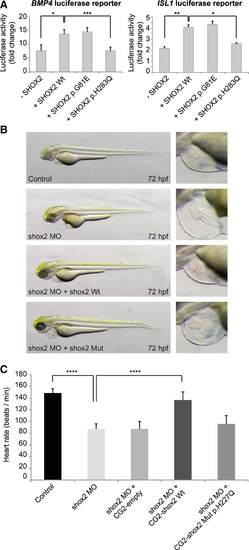- Title
-
Coding and non-coding variants in the SHOX2 gene in patients with early-onset atrial fibrillation
- Authors
- Hoffmann, S., Clauss, S., Berger, I.M., Weiß, B., Montalbano, A., Röth, R., Bucher, M., Klier, I., Wakili, R., Seitz, H., Schulze-Bahr, E., Katus, H.A., Flachsbart, F., Nebel, A., Guenther, S.P., Bagaev, E., Rottbauer, W., Kääb, S., Just, S., Rappold, G.A.
- Source
- Full text @ Basic Res. Cardiol.
|
Functional characterization of the SHOX2 coding variants. A Luciferase activity of BMP4 (left) or ISL1 (right) luciferase reporter constructs co-expressed with SHOX2 wild type (Wt) or SHOX2 mutants (p.G81E; p.H283Q) in HEK293 cells (human embryonic kidney cells), determined 24 h after transfection. All values are reported as fold changes of luciferase activity normalized to the empty vector (pGL3 basic) co-transfected with the respective expression constructs. Data are expressed as mean ± SEM of four independent experiments performed in triplicate. p values were determined by a paired t test (*p < 0.05; **p < 0.01; ***p < 0.001). B Injection of shox2 antisense morpholino (MO), which leads to pericardial edema and pericardial blood congestion due to reduced heart rates in zebrafish can not be rescued by cardiomyocyte-specific overexpression of shox2 Mut p.H227Q (corresponds to human SHOX2 p.H283Q mutation) compared to shox2 Wt (wild type) 72 h post fertilization (hpf). C The mean heart rate of control embryos 72 hpf amounts to 149 beats per minute (bpm). After shox2 knockdown, the heart rate is significantly reduced to 87 bpm. While cardiomyocyte-specific overexpression of Wt shox2 rescues the MO-mediated bradycardia (137 bpm), overexpression of shox2 Mut p.H227Q does not alter the reduced heart rate significantly at 72 hpf (95 bpm). Data are expressed as mean ± SEM of 3 independent experiments. p values were determined by one-way ANOVA with Sidak’s multiple comparisons test (****p < 0.0001; ns not significant; n = 10-16 per condition per experiment) PHENOTYPE:
|

